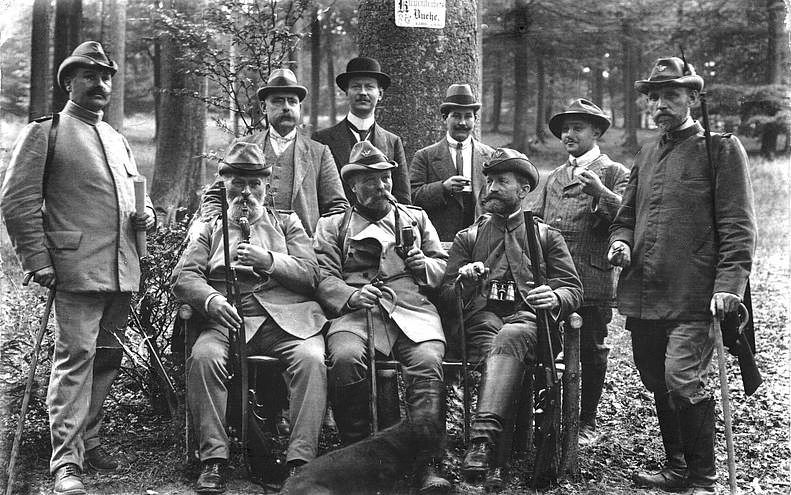
Another version of this essay appears in Hunting & Safari Magazine

A group of German hunters of the late 19th or early 20th Century. The man seated at far right, who is dressed as a forester, is holding a drilling in his left hand; it has external hammers and a "Roux" breech opening lever under the trigger guard.
The title of this essay is misleading: there is no one gun capable of doing anything a hunter might want it to do. But for 90+% of hunters, there are designs that pretty much meet that criterion. “Combination guns” of one sort or another are a very old idea, as useful to the modern hunter as they were to those of the past.
An “all around gun” must, by definition, be useful for stalking both large and small game, as well as for wingshooting. It must therefore be chambered for calibers suited to any game a hunter might encounter. Obviously it has to have mechanical features to select the proper ammunition to be fired. No single-barreled gun can meet these requirements: it follows therefore that such a gun must be multi-barreled.

These are a few of the many possible arrangements of barrels on combination guns. The most common arrangements are two barrels, either side by side (“Cape guns”) or over/under; and the three barrel drilling (from drei, German for three). The more barrels there are the harder it is to regulate them to shoot to the same point of aim: regulation is a laborious process and hence combination guns are usually very expensive to produce.
At the right is the business end of a "vierling," a combination with four barrels. The fourth barrel of a vierling is typically a small caliber such as .22 Long Rifle. It may be in the top rib, the center, or off to one side.
Over the course of centuries, many varieties of combination guns have evolved: common features include presence of a shotgun barrel (or barrels) and a rifle barrel (or barrels) with some form of selector device.

 The best known and most common combination gun designs are the 2-barreled “Cape Gun” (at left) and the three-barreled “drilling” (at right: the name is from German drei, meaning “three”). Cape Guns always have a rifled barrel and a smoothbore barrel as well.
The best known and most common combination gun designs are the 2-barreled “Cape Gun” (at left) and the three-barreled “drilling” (at right: the name is from German drei, meaning “three”). Cape Guns always have a rifled barrel and a smoothbore barrel as well.
The term “Cape Gun” is derived from this design’s popularity with settlers and immigrants to South Africa; the term is more or less specifically applied to a side-by-side arrangement with one barrel of each type. Over-under combination guns are commonly encountered but for some reason they aren’t called “Cape Guns,” though they have the same capabilities.
Percussion-type Cape Guns dating from the pre-cartridge era are fairly common, but most of those encountered nowadays are chambered for fixed ammunition. Typical shotgun bores are 12 and 16, with a rifle barrel somewhere between 9mm and 11mm caliber, occasionally larger, especially if it was sold into a market such as Africa or India. For foraging and use on lighter game, the Cape Gun found great favor for obvious reasons.
Drillings have three barrels, usually one rifle and two smooth. They are invariably breechloaders because it’s very difficult—though not entirely impossible—to design a mechanical system by which three separate barrels can be fired using percussion caps. While the Cape Gun is traditionally associated with Africa, the drilling is a European style, especially popular in central and eastern Europe, where a day’s outing may provide the opportunity to take deer, boar, hares, rabbits, and various game birds. Four-barrel guns (“vierlings”) have been (and are being) made but mechanical complexity and expense make them relatively uncommon items.
Breech-loading combination guns are break-actions because this design is physically compact, less mechanically complex than repeaters, and well adapted to multiple barrels. The designer’s goal of a useful hunting gun that’s well balanced and not overly heavy is relatively easy to achieve with two barrels. When there are three barrels (or more) it’s harder to do but the break action can be so built to make it possible relatively easily.
Drillings and Cape Guns on today's market are usually of German or Austrian origin, though they have been made in other countries. Drillings found special popularity among the foresters of central and eastern Europe, whose job was active, in-the-field game management and control of predators.
There was a real market for drillings and over-under combination guns in Europe, especially among gamekeepers and foresters. The complicated lockwork of drillings and the hand-fitting required to make them reliable and accurate made them expensive but essential tools: it’s difficult to imagine a more useful design for the day-to-day tasks of culling deer or boar or eliminating weasels or foxes. The landowners for whom foresters worked also often favored drillings, many of which were heavily engraved, highly decorated works of art, a testimony to the owner’s affluence. But in terms of functionality and precision they are not a whit different from the plain-vanilla workaday guns getting hard daily use.
The versatility of combination guns wasn’t the only reason they were popular. Though quite expensive, a good combination gun often cost less than buying a rifle plus a shotgun of similar quality. In countries where restrictions on the number of guns one may possess exist, a combination gun avoids the bureaucratic nuisance (and expense) of multiple licenses. This last justification is one reason they’re nowhere near so popular in North America as in Europe: Americans and Canadians have no significant restrictions on the number and type of hunting weapons they may own, so they tend to buy “specialized” guns for different hunting experiences. Then too, someone hunting in North America is typically after one specific species: the variety of game animals that might be encountered in a single day is less would be typical of Europe or Africa, so a drilling’s versatility is less relevant.
Calibers and gauges are chosen based on the game to be hunted, the size of the market in which the guns are sold, and esthetic factors. In drillings, 16 gauge shotgun barrels are by far the most common. Though larger (12) and smaller (20 gauge and .410 bore) drillings have been and are made, the 16 represents a good compromise between performance, balance, weight, and eye appeal. A 16 gauge offers significant performance advantages over a 20 (especially when chambered for shells shorter than 2-3/4 inches), and it permits use of thin-walled, lightweight shotgun barrels, no small matter when weight is an issue. Drillings are intended to be carried. Some of them are very light-weight (often modern ones have Duralumin receivers to cut weight down) and all of them are equipped with sling swivels.
Cape guns typically have a 12 gauge shot barrel (though other gauges are by no means unknown). With two barrels it’s easier to keep the overall weight within reasonable limits and a larger bore can be used.
Rifle calibers are far more varied, ranging from .22 rimfires to heavy calibers suited to dangerous game. The classic three-barreled drilling usually has a rifle barrel somewhere between 6.5 mm and 9mm, occasionally (especially in older ones using black powder ammunition) up to 11mm. The rifle barrel will most often be located beneath paired side-by-side shotgun barrels but other arrangements are possible. Drillings are popular in European countries where the game is neither exceptionally large nor exceptionally dangerous, and medium-bore calibers are more than adequate.
Cape Guns, intended for use in Africa, often have rifle barrels of larger caliber, capable of firing heavy bullets against very large animals. This is especially the case in guns of the black powder era, when the only way to achieve better ballistics was to shoot a larger bullet. The improvements that smokeless powder produced means that modern Cape guns could shoot smaller bore bullets at higher velocity than black powder guns could attain, but they still usually are chambered for bigger rounds than a drilling would be.
Both Cape Guns and drillings can have either external or internal hammers. The internal-hammer design is somewhat more modern and usually chambered for more powerful rifle rounds than the external hammer types. Though there are many exceptions, external hammer drillings tend to pre-date about 1930, with most of them dating from around World War One. In some respects the hammer drilling is simpler to build than one with internal strikers, and they’re usually chambered for rifle rounds that were popular in the late 19th and early 20th Centuries.
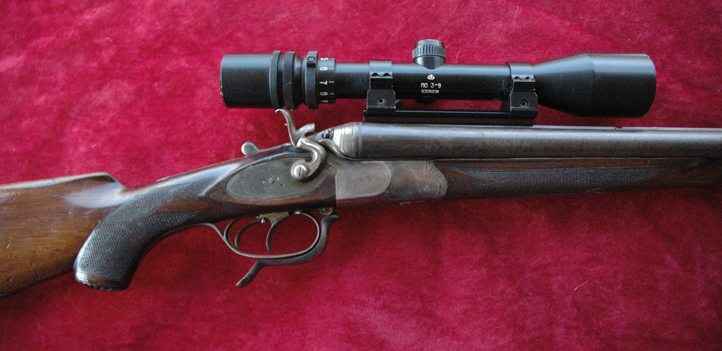

The drilling at top is a hammer gun produced by an unknown maker in 1926. It’s a sidelock with a “back action” mechanism, in which the mainspring is behind the hammer pivot. The rifle barrel is chambered in 16/16 9.3x72R, a once-popular medium power round well suited to game in Europe. The right external hammer fires both the right shot barrel and the rifle barrel: the lever on the tang is not for opening the gun: it’s a selector to shift the hammer to the rifle barrel. The curved lever under the trigger guard opens the breech. The underlever marks this as a “Roux” breech system, most commonly found in older guns. This type of gun lacks the cross-bolt lockup and is suited mainly to lower-power calibers.
The lower gun is a drilling made by Hermann Burgsmüller in 1940. It has hidden strikers. The selector for the rifle barrel is on the tang, where most shotgunners would think to find a safety catch. This gun is in 16/16/8x57JR, a far more powerful round that requires a most substantial locking system. Below is the left side of the Burgsmüller, showing the "Greener cross bolt" and Greener type safety used.
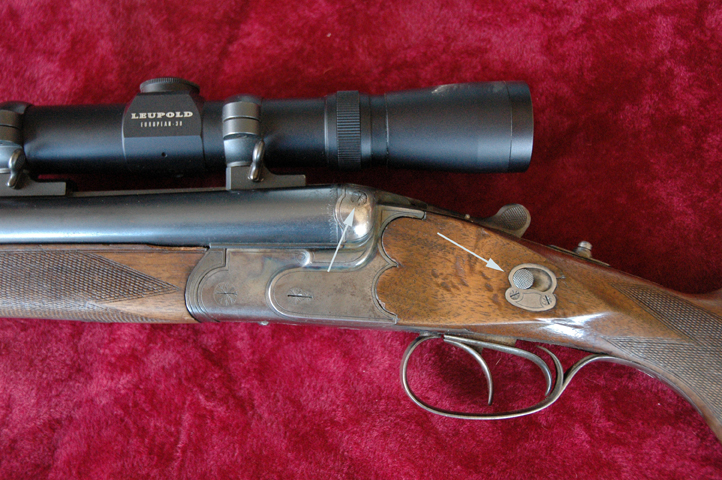
The Greener cross bolt is a solid bar that passes through a barrel extension and locks the breech to the recoil shield. This is in addition to the usual under-lug locking: Greener called it a "treble wedge-fast" system and it's much stronger than the Roux type gun above. The safety catch on a Greener-type action is a sliding button on the left stock wrist. Forward is "off." The button on the tang isn't a safety: it's a selector to permit shooting rifle barrel with the right trigger.
Both of these guns have been fitted with scopes in detachable mounts that return to zero when the scope is re-attached. That allows the shotgun barrels to be used on flying game birds.
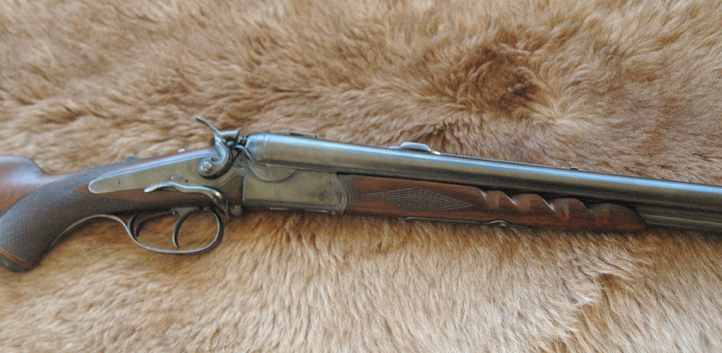
This beautiful drilling is by Carl Stiegele of Munich, and was made in 1928. It has a relatively uncommon unlocking lever on the right side, and back action locks. The lever on the top tang is to select the rifle barrel. Note the grooves in the fore-end for the shooter's fingers! This was almost certainly done at the customer's request: German gunsmiths often made guns to order and customers got whatever they specified.
The Stiegele gun has "claw mounts" for a detachable scope (below). Alas, the scope for this gun was long ago separated from it; and since the matching of a scope to its gun is unique, replacing the mounts would be a very costly process of custom fabrication.
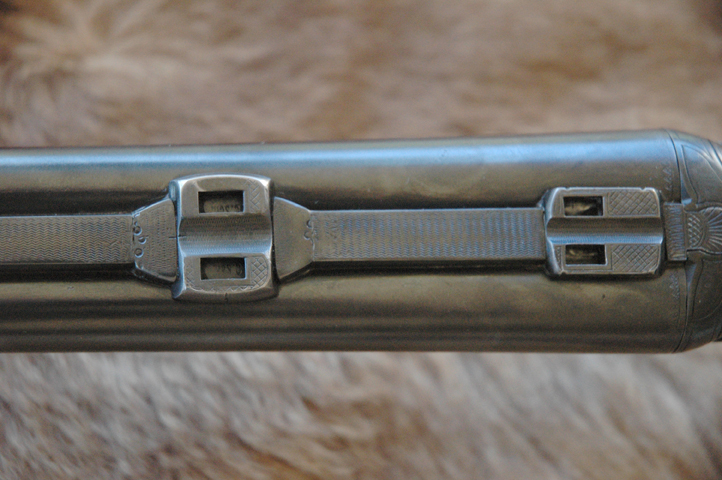

 Combination guns have been made in the USA. Probably the most successful (and certainly the best known) of these has been the over-unders made by Savage Arms, usually called “Model 24’s.” Two examples of this long-lived series are shown above. The top is a .22 Long Rifle/20 gauge over/under; the bottom is in .30-30 over 12 gauge. The small caliber gun has been extensively modified to produce a more or less specialized squirrel-killing machine: it has had the barrels shortened to 20” and replaceable choke tubes fitted. Any squirrel within 50 yards is a sure kill. The larger gun is unmodified and was one of the last Model 24’s produced.
Combination guns have been made in the USA. Probably the most successful (and certainly the best known) of these has been the over-unders made by Savage Arms, usually called “Model 24’s.” Two examples of this long-lived series are shown above. The top is a .22 Long Rifle/20 gauge over/under; the bottom is in .30-30 over 12 gauge. The small caliber gun has been extensively modified to produce a more or less specialized squirrel-killing machine: it has had the barrels shortened to 20” and replaceable choke tubes fitted. Any squirrel within 50 yards is a sure kill. The larger gun is unmodified and was one of the last Model 24’s produced.
The over/under arrangement of the barrels, as seen for example, on the Model 24 would be called a bockbuchseflinte configuration in German. It's more common to find the shotgun barrel on the top than on the bottom, however, as in the Valmet gun below. The upper barrel exerts force on the standing breech in proportion to its chamber pressure: because shotgun pressures are fairly low, the shotgun-over configuration stresses the action less. But with low pressure rounds like .22 LR and .30-30, the rifle barrel on top works as well and has the advantage of putting the rifle sights closer to the axis of the bore.

The first Savage Model 24’s date from the late 1930’s, but in various configurations of calibers and gauges (from .22 Long Rifle/.410 bore to .30-30/12 gauge) they remained in production for decades. The “Model 24” as such was discontinued some years ago, but Savage, bowing to consumer demand, recently re-introduced the “Model 42,” an updated version in .22/.410. It is nowhere near so sleek and attractive as its ancestor, but it’s just as functional as a small game gun.

 American-made drillings are rare things, but they do exist. The L.C. Smith and Lefever companies produced drillings starting in the 1880’s. L.C. Smith also made drillings under the Baker name. The best-known American drilling is the hammerless gun produced by the “Three Barrel Gun Company” in West Virginia around the turn of the 20th Century. They may also be labeled "Hollenbeck," after their designer. Hollenbeck or Three-Barrel guns are scarce; they were usually 12 gauge/12 gauge over the .32-40. That made them suitable for most thin-skinned eastern North American animals, though underpowered for really large game such as moose or grizzly bear.
American-made drillings are rare things, but they do exist. The L.C. Smith and Lefever companies produced drillings starting in the 1880’s. L.C. Smith also made drillings under the Baker name. The best-known American drilling is the hammerless gun produced by the “Three Barrel Gun Company” in West Virginia around the turn of the 20th Century. They may also be labeled "Hollenbeck," after their designer. Hollenbeck or Three-Barrel guns are scarce; they were usually 12 gauge/12 gauge over the .32-40. That made them suitable for most thin-skinned eastern North American animals, though underpowered for really large game such as moose or grizzly bear.
No less renowned a hunter than Theodore Roosevelt recognized the value and utility of combination guns. In Hunting Trips of a Ranchman, his famous account of his years in North Dakota in the 1880s, he wrote:
On regular hunting trips I always carry the Winchester rifle; but in riding around near home, where a man may see a deer and is sure to come across ducks and grouse, it is best to take the little ranch gun, a double-barrel No. 16, with a .40-70 rifle underneath the shotgun barrels.
Roosevelt’s “little ranch gun” still exists: it’s on display in the museum at the South Unit of Theodore Roosevelt National Park in Medora, North Dakota. I've seen it, but was unable to have access to it out of its display case. Roosevelt undoubtedly preferred American manufacturers and given the dates of his residence there, the most probable manufacturer was Baker, i.e., a Three Barrel Gun. The Baker catalog of 1884 pretty well sums up the argument for drillings, and echoes TR’s words:
It is a fact too well known to need mention, that in going out for the purpose of killing small game with a shot gun, one is constantly having unexpected chances to shoot at larger game that a shot gun will either not reach at all, or fail to kill; and to those who are in the habit of hunting in localities where there are animals that are dangerous, and which are liable to be encountered at any moment without warning, this gun gives the possessor feelings of confidence and safety that are invaluable, to say nothing of the extra amount and actual value of the game that can be obtained by its use . . .
The “.40-70” Roosevelt refers to probably is the .40-70 Maynard round introduced in 1882: a typical black powder cartridge of the era, firing a 260-grain lead bullet at about 1500 feet per second. This would be adequate for the deer on Roosevelt’s ranch, though a bit underpowered for elk and grizzly.
Many famous European makers’ names are associated with drillings: Merkel, Krieghoff, Blaser, Heym, and Sauer, to name a few who are still in the business. Many other less-well-known firms in Germany and Austria, and many local gunsmiths, made drillings and combinations guns in the period before World War Two, but unfortunately the records of these smaller makers were usually destroyed in the conflict or afterwards by the occupation forces; and there are reliable accounts of hundreds of these beautiful custom pieces being burnt or crushed by tank treads.
Luckily quite a few German guns were “liberated” by American soldiers who, under the rules in effect at that time, were allowed to bring them home as war souvenirs. Many fine examples of German and Austrian combination guns and drillings were saved in this way; as that generation dies off, many of their prizes are coming back onto the market via auction sites and gun shops.
Any combination gun will not only add a new dimension and more flexibility to your hunting experience, it may well become your “go to” hunting weapon and a new favorite. But anyone who has become intrigued by the idea of an “all around gun” and who may be contemplating buying an old one should be aware of a few things.
The first is the matter of ammunition. As mentioned, the most common shotgun gauge in drillings is 16, but sometimes 20 gauge guns turn up for sale. Shotgun chambers of older European guns (especially in 16 gauge) are almost always for 2-1/2” (65mm) shells, not the far more common 2-3/4” length used today. A gunsmith can check this easily and lengthen the chambers if desired.
It's the rifle barrel calibers that can be very confusing and which have to be approached with a bit of caution and common sense. In the late 19th and early 20th Centuries many a gun maker used a “proprietary” caliber, i.e., one he’d designed and for which he was the sole source. In Europe this was not too much of an issue, because a gunsmith typically served a small area and customer base: his clients likely didn’t use many cartridges in a year and he would always have a ready supply. But people who went abroad, people whose finances didn’t run to custom ammunition, or people who went through many rounds in a season preferred to use standardized and readily-available rounds. Nevertheless, it’s not at all uncommon to find an older combination gun or drilling that isn’t marked with any reliable indication of the rifle caliber. The older the gun is, the likelier this is to be the case.
Germany instituted mandatory proof laws and hence standardization of ammunition only as late as 1891. With the establishment of mandatory proof proprietary calibers began to fade out. Proof marks can be a rough guide to the date of manufacture, so it's smart to get a good book on the subject to "key out" a gun. The only certain way to determine what a rifle barrel gun shoots is to make a chamber cast. This isn't difficult, and standard reference books on ammunition will provide reference measurements.
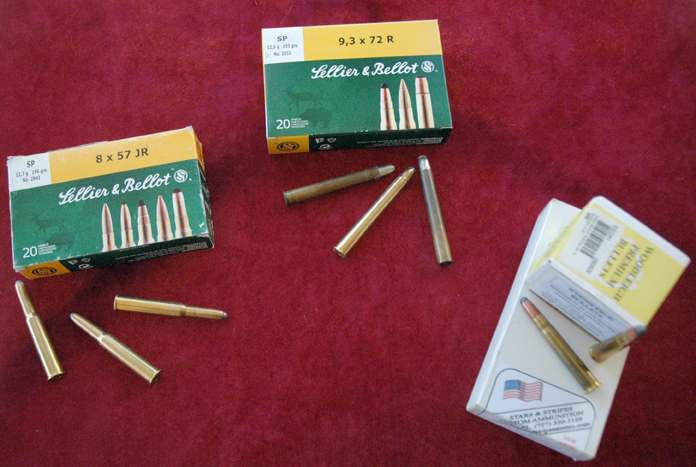
Classic calibers for drillings include, left to right: 8x57JR, 9.3x72R, and 8x57JR/360. The 8x57JR is in the same power category as the .308 Winchester (when using the same weight bullet). The 8x57JR/360, however, is significantly less powerful than the 8x57JR; it's about like a .30-30. The two "8x57" cases, despite the similar length, will not interchange, but both use a 0.318” bullet.
The 9.3x72R is roughly comparable in power to the .38-55; it was one of the first German calibers to be standardized when proof laws went into effect, and is sometimes headstamped “N” or “Normal” to indicate that it meets the post-1891 standards.
Drillings may be encountered in many other calibers from .22 Hornet up, with 6, 6.5, and 7 mm rounds being well favored in Europe. Old guns may be chambered in “proprietary” calibers for which ammunition is more or less unobtainable. It's generally not a good idea to have one of these guns rechambered, there are no proof standards and/or proof loads available. It might be safely done in Germany, but I doubt it.
Even if an old gun is marked, the marking may not tell the owner much. For example, “8x57” by itself means little: at least 4 different “8x57” rounds were used in drillings dating from 1890 to 1940. While modern shooters may think “8x57” means the common "8mm Mauser" or its rimmed equivalent, I’ve encountered at least one 1890’s vintage hammer drilling marked “8x57” that in fact was chambered for one of the most obscure calibers ever made, one based on an even more obscure British sporting round. Such a gun is strictly for the advanced handloader who wants a challenge and is willing to invest in the components and the tools to make and load his own ammunition.
Worse yet, until cartridge standardization was completed, “8mm” often meant different things to different gunsmiths. Smiths usually made their own gauges, which varied from one shop to another. Frequently such gauges indicated not groove diameter of the barrel, but the bore diameter, considerably less. Such guns—if marked at all—may be marked “7.7mm” or “7.8mm” instead of “8mm”! Large-bore guns may be marked “8.8,” “9,” or “11” millimeters, with no further indication which if any of the many variations of such ammunition was used. To complicate matters even further, today’s “8mm” calibers aren’t always the same as those of yesteryear.
Until 1905, the Imperial German Army issued rifles in 8x57mm (sometimes marked as “7.92x57,” but you get the idea…) and these rifles used a bullet of 0.318” diameter. After 1905 the design of the military bullet was changed and the new, post-1905 issue ammunition used a slightly larger 0.323” bullet. The older size was designated the “J” bullet (for “Infanterie,” the letters “J” and “I” being interchangeable in German) and the post-1905 the “S” bullet.
 But hunters and shooters being conservative types, the use of the “J” sized 0.318” bullet continued in sporting guns for many, many years after the Army had changed over. It’s virtually certain that any German- or Austrian-made combination gun or drilling in “8x57mm” dating from before about 1950 (and many after that date) will require the smaller “J’ bullet. It’s important to understand the difference and the nomenclature used on ammunition boxes.
But hunters and shooters being conservative types, the use of the “J” sized 0.318” bullet continued in sporting guns for many, many years after the Army had changed over. It’s virtually certain that any German- or Austrian-made combination gun or drilling in “8x57mm” dating from before about 1950 (and many after that date) will require the smaller “J’ bullet. It’s important to understand the difference and the nomenclature used on ammunition boxes.
Rimmed cases work best in break open guns: a caliber marking of “8x57J R” means the rimmed 8x57 round with the smaller bullet: one of “8x57JR S” indicates the 0.323” size. Regrettably, “J” bore ammunition is so uncommon today that often the “S” marking is omitted, which can easily present problems. All American made "8mm" ammunition uses 0.323" bullets; and only one or two companies (chiefly Woodleigh and Buffalo Arms) make the 0.318" diameter bullet as a reloading component at all. Using the larger bullet in the smaller barrel can be a recipe for disaster!
The Czech firm Sellier & Bellot is the only current producer of the 8x57JR ammunition. A box of it is shown above. This cartridge is loaded with a 196-grain bullet at modest velocity and is very accurate. Power is roughly comparable to the 8x57mm Mauser round used in the Model 1898 and more than adequate for 99% of North American game. I have used it on whitetails, feral hogs, and in Africa on ostrich, and never failed to get a one-shot kill. Norma used to load this caliber but today only makes the 8x57JRS, with the 0.323" bullet. More's the pity: I have used Norma's excellent 0.318" bullet in handloads with great success, but it too has been dropped from their line of loading components. S&B currently make the 9.3x72R but it may discontinue that round in the future due to diminishing demand. Reloading dies for all these calibers (even the obscure 8x57JR/360) are available from Buffalo Arms, CH-4D, and other companies.
The moral of the story is that when dealing with old unmarked guns, or guns whose markings are unclear, it’s necessary to make a chamber casting of the rifle barrel and to “slug” the bore to determine the proper caliber. These procedures are inexpensive and ensure safety.
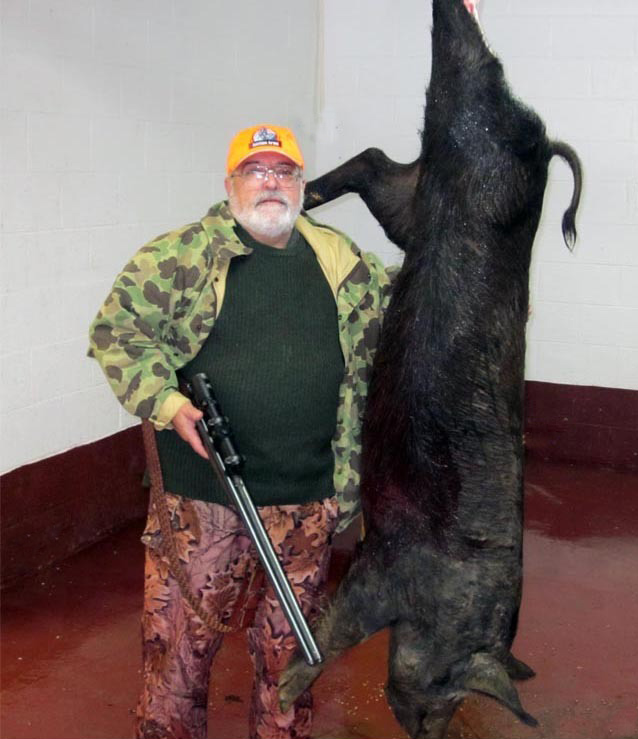
The classic game for a drilling is, of course, the wild boar. I took the piggie at left with my Burgsmüller, on a hunt in Tennessee. But I've used it on deer and on birds, too. Bird shooting with a drilling isn't much different from doing it with a double shotgun, but of course the scope has to be removed if they're flying.
In 2013 I took this gun to Namibia, as a "light rifle" plus a shotgun. One day we went to a waterhole, where the sand grouse were flying, and with it I also killed a guinea fowl. One bird required the rifle barrel: a full-grown male ostrich who was dispatched cleanly with a single shot. While waiting in a hide, a few black-backed jackals unwisely showed themselves, and the rifle barrel dropped them all cleanly.


 Anyone who opts for an “all around gun” and puts a little thought into the purchase will never regret buying one. In the hands of a good marksman and wingshot they perform reliably and effectively, especially given the far superior ammunition we have available compared to that used by our fathers and grandfathers.
Anyone who opts for an “all around gun” and puts a little thought into the purchase will never regret buying one. In the hands of a good marksman and wingshot they perform reliably and effectively, especially given the far superior ammunition we have available compared to that used by our fathers and grandfathers.
New-made guns, especially drillings, from “name” makers are very, very expensive. But it’s not necessary to spend a fortune to get a good used gun: prices for high-quality old drillings, even from “name” makers, are far lower than new-production guns, and very competitive with high-quality new rifles and shotguns. It’s very easy to find a pre-World War Two gun from a well-respected maker for well under $4000, usually much less. So-called “guild guns,” those without a maker’s name, are even less expensive. While $2000-$3000 may sound like a lot of money, the level of craftsmanship and accuracy of these guns of the "Golden Age of German Guns" is simply astonishing, and couldn't be matched by any modern maker in less than five figures—about where the prices for a new-made Heym or Merkel start.
It’s advisable to have a gunsmith check any older gun, but neglected or damaged specimens are pretty scarce: most of the ones coming back onto the market were cherished possessions, very well cared for by their owners and still in sound shape. Few of them were shot very much, if at all, after they were captured, thanks to scarcity of proper ammunition in the USA when they were brought home. They were brought home as prizes because  of their beauty and unusual design. Gun fairs,
of their beauty and unusual design. Gun fairs,  Internet auction sites, and small gun shops are all good places to find such bargains. Another very good source is the "Gun Library" service of the Cabela's company. A Google search on the term "drilling gun" will turn up many for sale.
Internet auction sites, and small gun shops are all good places to find such bargains. Another very good source is the "Gun Library" service of the Cabela's company. A Google search on the term "drilling gun" will turn up many for sale.
There are resources for collectors as well. The German Gun Collectors' Association and German Hunting Guns are two exceptionally useful sites. Two books on the subject of drillings are on the market: Amazon carries The Drilling Gun by Norbert Klups and Safari Press has recently published German Hunting Guns of the Golden Era by Hans Pfingsten. Both are in English (though Klups' translations can be difficult to follow) and both are beautifully illustrated. Klups' book is oriented more to modern-made guns, while Pfingsten's, as the title implies, is focused on the classics. Both are well worth their price.
| HUNTING | GUNS | DOGS |
| FISHING & BOATING | TRIP REPORTS | MISCELLANEOUS ESSAYS |
| CONTRIBUTIONS FROM OTHER WRITERS|
| RECIPES |POLITICS |